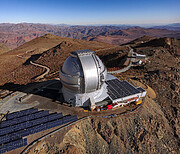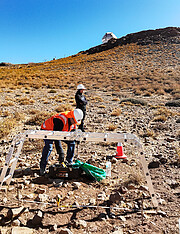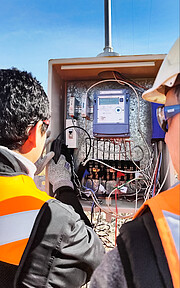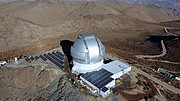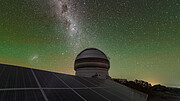NSF’s NOIRLab On Track to Reduce Carbon Emissions by Half
Gemini South to reach zero carbon dioxide emissions and Rubin Observatory summit facility to run on 60% renewable energy by 2027
27 November 2023
Through its Environmental Sustainability Program, NSF's NOIRLab will reduce its entire annual carbon footprint by 50% by the end of 2027. This will be achieved through allocations of supplemental funding from the National Science Foundation towards installing solar panels and batteries at Gemini South and Vera C. Rubin Observatory in Chile as well as other upgrades at both NOIRLab’s Base and Summit facilities.
Conducting frontier research into the wonders of the Universe is a never-ending pursuit that requires observatories to have a reliable source of energy to power their operations. NOIRLab recognizes the impact that its energy needs have on the environment and surrounding communities and is thus committed to minimizing the environmental impact of its facilities and operations in Arizona, Chile and Hawai‘i. This commitment incorporates diverse initiatives ranging from reducing NOIRLab’s facilities’ grid electricity usage and staff air travel to making improvements to base facility equipment and infrastructure. Projects such as these will allow NOIRLab to maintain good stewardship both locally and globally.
Guiding this endeavor is NOIRLab’s Environmental Sustainability Program, which aims to reduce NOIRLab’s entire annual carbon output by 50% by the end of 2027, relative to the 2019 baseline and including the Vera C. Rubin Observatory operations at Cerro Pachón. Without action, NOIRLab's current carbon footprint is approximately 12,500 tons CO2 equivalent per year. The goal is to reach 6200 tons CO2 equivalent by late 2027 — a reduction comparable to the footprint of the annual electricity consumption of 1250 typical US houses.
This goal will be achieved thanks to generous funding from the National Science Foundation. With the approved supplemental funding, NOIRLab will install one large integrated photovoltaic (solar panel) and battery energy storage system to feed the facilities on Cerro Pachón in Chile. In particular, this system will cover 100% of the electricity usage from the Gemini South telescope, one half of the International Gemini Observatory operated by NSF’s NOIRLab, and about 60% of Vera C. Rubin Observatory’s electricity needs [1]. When completed the joint system will comprise a 2860-kilowatt photovoltaic system paired with a 11-Megawatt Hour (MWh) battery storage system. This system will produce about 5300 MWh of electricity annually and will reduce NOIRLab’s annual carbon footprint by 2900 tons CO2 equivalent — comparable to the annual electricity consumption of about 500 typical US houses.
The impact of such actions will not only benefit the environment on a local and global scale, but may also serve as an inspiration to the users of the telescopes and other research facilities. To encourage participation, NOIRLab is working to modify an existing tool for carbon footprint calculations for use across research facilities in the US.
“NSF's NOIRLab is taking a leading role among international observatories in adopting more sustainable practices, such as the use of renewable energy sources, and also taking a close look at how operations can be made more energy efficient,” says Chris Davis, NSF’s Program Director for NOIRLab.
With the broader goal of achieving a 50% CO2 reduction by the end of 2027, NOIRLab’s Environmental Sustainability Program also addresses a recommendation made in the Astro2020 report, Pathways to Discovery in Astronomy and Astrophysics for the 2020s, which states, “The astronomy community should increase the use of remote observing, hybrid conferences, and remote conferences, to decrease travel impact on carbon emissions and climate change.” In response, NOIRLab is committed to reducing funded staff travel by approximately 50% by late 2026. This effort will also free up additional funding to be used to install energy-efficient equipment and solar panels across the facilities.
Using additional approved supplemental funding from the NSF, NOIRLab also proposes various other upgrades to the base and summit facilities in Arizona and Chile. This includes replacing the very old heating, ventilation, and air conditioning system in the NOIRLab Headquarters building in Tucson. This upgrade is expected to reduce the electricity usage by 690 MWh annually and reduce the carbon footprint from the facility’s electricity use by around 300 tons CO2 equivalent annually. Funding will also cover the replacement of eight gasoline/diesel powered vehicles with electrical vehicles — the first phase of a larger shift to electric vehicles across the sites. Other funded projects include the installation of high-efficiency transformers, LED lighting, and energy-efficient data centers at NOIRLab’s facilities in Arizona and Chile (similar changes have already been implemented at the Hawai‘i facilities).
With currently approved funding, NOIRLab will achieve a reduction in its carbon footprint of about 43%. But the efforts will not stop there. Further funding to reach the goal of 50% reduction by 2027 is actively being pursued.
These changes, both large and small, will bring NOIRLab closer to a more environmentally sustainable reality, allowing the facilities to continue making breakthroughs in astronomy while caring for our environment. Minimizing environmental impact is not just a possibility, it is a responsibility that NOIRLab is committed to act upon.
More information
Notes
[1] The final figure depends on final approved funding from NSF.
More information
NSF’s NOIRLab (National Optical-Infrared Astronomy Research Laboratory), the US center for ground-based optical-infrared astronomy, operates the international Gemini Observatory (a facility of NSF, NRC–Canada, ANID–Chile, MCTIC–Brazil, MINCyT–Argentina, and KASI–Republic of Korea), Kitt Peak National Observatory (KPNO), Cerro Tololo Inter-American Observatory (CTIO), the Community Science and Data Center (CSDC), and Vera C. Rubin Observatory (operated in cooperation with the Department of Energy’s SLAC National Accelerator Laboratory). It is managed by the Association of Universities for Research in Astronomy (AURA) under a cooperative agreement with NSF and is headquartered in Tucson, Arizona. The astronomical community is honored to have the opportunity to conduct astronomical research on Iolkam Du’ag (Kitt Peak) in Arizona, on Maunakea in Hawai‘i, and on Cerro Tololo and Cerro Pachón in Chile. We recognize and acknowledge the very significant cultural role and reverence that these sites have to the Tohono O'odham Nation, to the Native Hawaiian community, and to the local communities in Chile, respectively.
Links
Contacts
Inger Jorgensen
NSF’s NOIRLab
Email: inger.jorgensen@noirlab.edu
Josie Fenske
NSF’s NOIRLab
Email: josie.fenske@noirlab.edu


